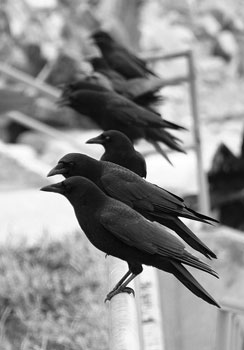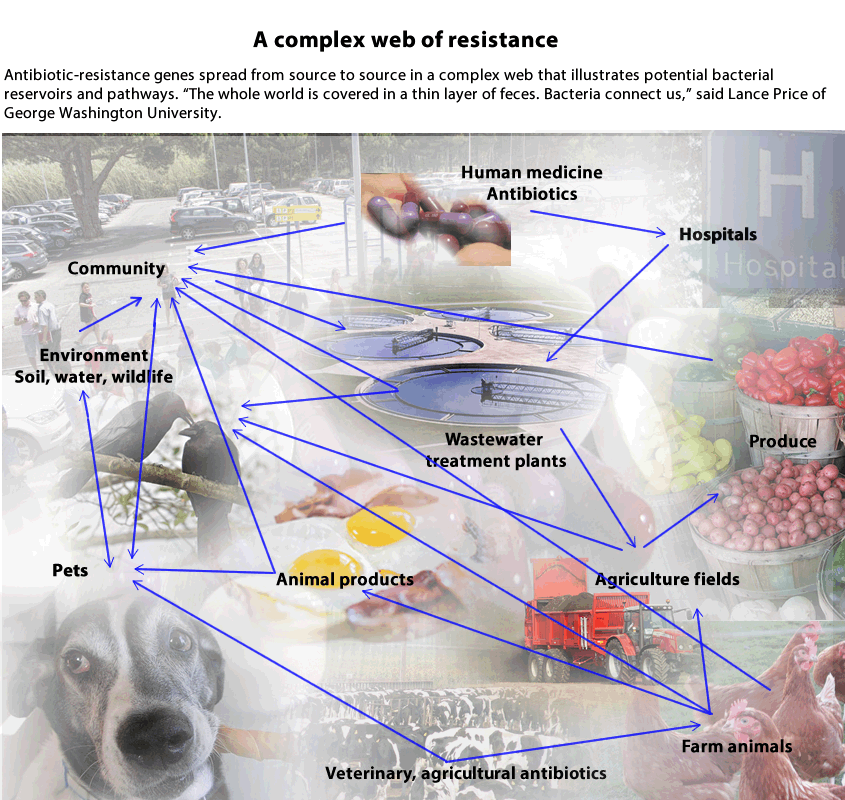Flying the coop: Antibiotic resistance spreads to birds, other wildlife
New research, including a crow poop study conducted in four states, provides evidence that antibiotic resistance has spread beyond hospitals and farms to wildlife.
 |
|
| Lindsey Konkel/EHN | |
|
Scientists tested crow feces at Coes Pond in Worcester,
Mass., and found antibiotic-resistance genes in the
bacteria. |
Staff Writer
November 5, 2013
WORCESTER, Mass. – One afternoon last winter, Julie Ellis unfurled a long, white tarp under a stand of trees near Coes Pond where hundreds of crows roost. Her mission: to collect as much bird poop as possible.
Back in the laboratory, Ellis’ colleagues combed through the feces. Testing its bacteria, they discovered something unusual – genes that make the crows resistant to antibiotics.
 |
| Brad Smith/flickr |
| Bacteria in crow poop harbors genes for resistance to a drug used to fight hospital infections. |
Drug-resistant infections are a fast-growing threat to human health, due largely to overuse of antibiotics in human medicine and livestock production, according to the Centers for Disease Control and Prevention. At least 2 million people each year in the United States alone are sickened by infections resistant to drugs.
Now new research, including the crow poop study conducted in four states, provides evidence that antibiotic resistance has spread beyond hospitals and farms to wildlife.
“We’ve documented human-derived drug resistance where it shouldn’t be – in wildlife and the environment. But we know very little about how this may impact public health.” –Julie Ellis, Tufts University Some experts worry that contaminating wildlife with such genes may hasten the spread of drug resistance. Nevertheless, the consequences for human health remain poorly understood.
“We’ve documented human-derived drug resistance where it shouldn’t be – in wildlife and the environment. But we know very little about how this may impact public health. There just isn’t that smoking gun,” said Ellis, a research scientist at Tufts University’s veterinary school.
In addition to crows, resistance genes have been detected in the bacteria of gulls, houseflies, moths, foxes, frogs, sharks and whales, as well as in sand and coastal water samples from California and Washington.
The spread to wildlife is “an indicator of the wide-reaching scale of the problem. Microbes connect the planet,” said Lance Price, a professor of environmental and occupational health at George Washington University.
“The danger is that we enter a post-antibiotic era in which even our last-line drugs won’t work and routine infections become life-threatening,” he said.
While antibiotics have revolutionized medicine in less than 100 years, antibiotic-producing bacteria have existed in nature for millions of years. Natural antibiotics likely evolved as weapons in a biological arms race between competing bacteria.
But the environmental drug resistance that Ellis and others are now seeing is different – it’s manmade.
“What has changed is that we’ve placed great selective pressure on bacteria with our use of antibiotics,” said Ludek Zurek, a microbiologist at Kansas State University who participated in the crow study.
 |
| Julie Ellis |
| Scientists collected crow feces from a site in Worcester, Mass. |
Bacteria can swap genes with one another, so those that survive can pass along the genetic equipment to withstand an antibiotic assault to unrelated bacterial strains, spreading resistance across the globe, microbe by microbe.
“The danger is that we enter a post-antibiotic era in which even our last-line drugs won’t work and routine infections become life-threatening.” –Lance Price, George Washington University “Those bacteria that pick up resistance genes survive better in an environment where antibiotics are being used. They can outcompete all the other bacteria,” said Price, who advocates against the use of antibiotics in livestock.
In the crow research, scientists collected nearly 600 fecal samples in four states – Massachusetts, Kansas, New York and California. Fifteen of the crows sampled, about 2.5 percent, harbored genes for resistance to vancomycin, a drug of last resort for hard-to-treat hospital-acquired infections. Crows with the resistance genes in their feces were found in all of the states except California.
“The vancomycin resistance gene is rare [in environmental samples], so the fact that they readily found it in crows is significant,” said Amy Pruden, an environmental engineer at Virginia Tech who studies antibiotic resistance genes as emerging contaminants in water bodies.
What’s alarming, say the researchers, is that some of the vancomycin-resistant bacteria in the crows were resistant to several other antibiotics widely used in human medicine and livestock feed.
It’s very difficult to trace the resistance back to a source.
“Because birds are so mobile, it’s possible they may acquire resistance genes from multiple sources in their travels,” said Ellis. “Maybe they visit a dumpster or sewage treatment plant one day and later a farmer’s field.”
 |
| NIAID |
| Antibiotic-resistant infections are
common. |
The source of antibiotic-resistance cannot always be determined because many drugs are used both in human and animal medicine. However, the vancomycin resistance in the wild crows bears the signature of a human clinical source, the study authors concluded.
They speculate that waste sites may be a potential source of the crows’ bacteria.
“Traditional wastewater treatment approaches may not destroy genetic material,” Pruden said.
Much of the research on drug resistance has focused on hospitals and healthcare settings. The CDC estimates that 50 percent of all antibiotics prescribed to people are not needed.
More recently, researchers have begun to turn their attention to the environment as a source of drug resistance. Many more tons of antibiotics are used in U.S. livestock production – to prevent and treat disease and to promote growth – than in human medicine. An estimated 30,000 tons of antibiotics each year are sold for use in food-producing animals. “People who consume these foods can develop antibiotic-resistant infections,” according to a CDC report issued in September.
It’s unclear what role, if any, crows and other wild animals may play in hastening the spread of these infections or creating new ones.
“Wildlife may be an important piece of the puzzle,” Pruden said. “It’s certainly an area that warrants more research.”
 |
| Pauli Hayes/EHN |
The above work, by Environmental Health News,
Copyright © 2011 Environmental Health Sciences. All rights reserved.
